Pure Sports Car Pleasure
Editor’s Note: We don’t usually run back-to-back road tests of sports cars, but Road Test Editor John Faulkner had a chance to experience two of Toyota’s latest efforts, so we’re linking the two stories together so you can compare and contrast. Here’s a quick link to the 86 Hakone story. Two joint venture vehicles that can take you to a fun place.
Some of the cars I review are hard to give back. One week in the 2020 Toyota Supra Premium was not nearly enough seat time, for what may be the best handling and performance street car Toyota has ever built. There wasn’t anything I asked the Supra to do that it balked at, and several asks surpassed my expectations.

When the all-new Supra was announced as a joint venture between BMW and Toyota, Supra purists (who are now 20 years older from the last time they drove a new Supra, and their memories may be failing them) were outraged the Supra would be using the BMW Z4 engine, transmission and suspension. Before even sitting in the Supra, they already were lighting up the internet with derisive comments, and saying they would never own such a travesty. Well, my friends, it is their loss. The 2020 Supra is a wonderful car!
The Makings of a Fine Sports Car
The 3.0-liter inline six-cylinder with a twin-scroll turbocharger runs on 92 octane and produces 335 horsepower and 365 pound-feet of torque from 1,600 to 4,500 rpm. Our zero-to-60 times were around 4.0 exhilarating seconds, with power being delivered to the rear wheels through the eight-speed automatic with steering wheel-mounted paddle shifters. The transmission is built by ZF, pronounced “Zed-Eff,” a German company that provides technologies for several auto manufacturers in the areas of passive and active safety, electronics, steering and, of course, automatic transmissions.

Most people won’t be buying the Supra because of its EPA fuel economy rating of 24 mpg city/31 highway/26 combined. In our week, driving 285 miles throughout Southern California, with some of those miles above the speed limit and cranking out some fine turns on mountain twisties, we averaged 28 mpg. In a 150-mile all-freeway run with the dynamic radar cruise control set at 65 mph, we averaged 32.6 mpg. The almost imperceptible stop/start system and aero underbody panels also contributed to the better than expected fuel economy.
That 65-mph freeway run was painful, as the shelter-in-place orders meant the freeways were wide open, and the Supra really wanted to go much, much faster. We got the feeling that 65 mph is not even half of what the Supra can do when fully opened up. Fuel economy numbers reported by Clean Fleet Report are non-scientific and represent the reviewer’s driving experience. Your numbers may differ.
Hitting the Road
The Supra is a true sports car, but also can be a grand tourer as it can hold luggage for two and has a suspension that can comfortably handle a few hundred miles on the open road. The Supra has what Toyota calls an “optimal weight balance” of 50/50, which was apparent when diving into sharp corners. When pushed to the limits around a corner, the Supra would have slight body settling before it would grab and go. It was a blast to drive a rear wheel drive car hard into corners, realizing the Toyota engineers know what a sports car is supposed to feel like. This is a serious sports car that begs to be driven on a track.

The handling begins with the grippy Michelin Pilot SuperSport summer tires. The staggered tires, on 19-inch rims, 255/35 on the front and 275/35 on the rears, were predictable on corners or when applying the Brembo four-piston caliper brakes. One issue we had was the lane departure steering assist being overly aggressive.
There are two driver-selectable drive modes of Normal and Sport. For a more compliant ride and a quieter exhaust, Normal is where we kept it for all freeway and in-town driving. But when corners, freeway onramps and other demanding situations faced us, we quickly put the Supra into Sport mode. The result was a tighter/heavier steering feel, a firmer suspension due to the adaptive variable shock absorbers, vehicle stability control, an active sport rear differential and finally, the earthier note from the active exhaust that includes burbling, crackling and rumpling on acceleration, and especially when downshifting using the paddle shifters.
The lasting memory from the 3,397-pound Supra is its balance, which encourages spirited driving with excellent performance. The BMW twin-turbo straight-six was powerful and responsive, and the automatic transmission never having me wanting a manual. I can’t imagine having a third pedal would give the Supra any more performance, or make it any more fun to drive.
Anonymity Lost
Living in Southern California, the car capital of the world, we see just about every car make and model. We even see those that are camouflaged, prototypes in development and testing. So when cars are following you on the freeway, or pulling alongside to shoot videos, or people follow you into a parking lot and strike-up a conversation, you know you are driving something special–and rarely seen. This was the case of our 2020 Supra that, painted in Renaissance Red, was easy to spot–and for many–impossible to ignore.

There has been a difference of opinion by some regarding the 2020 Supra exterior design, but place me strongly in the camp of those who like it. Whether it’s cues from a Formula 1 nose or the curvy lines and the smooth integrated spoiler, the sleek Supra is unique and cuts a great image. The low 4.5-inch ground clearance drives home the point–the Supra is made for handling. The faux hood and door vents are not terrible, and I hope indicate the next generation Supra will open those vents to provide brake and engine cooling. The red calipers, peeking out through the twin-spoke aluminum wheels, were a nice touch.
The dominant design feature on the Supra is the long hood, which is necessitated to accommodate the BMW inline six-cylinder engine. The sleek six-lens auto-leveling LED headlights wrap onto the fenders, while daytime running lamps, in the form of an “L,” frame the headlights. The low roofline sweeps to the elongated hatch glass that ends with the sculpted spoiler and LED tail lights. Twin chrome exhaust tips are the finishing touches, along with LED back-up lights on the rear fascia.
Interior Optimized for Driving
The fifth generation 2020 Supra has two seats, which differs from previous Supras that had four. Limiting the all-new Supra to two makes a statement that kids and their car seats should be left at home. For some, accessing the Supra could be a challenge. With its low ride height and sloping roofline, flexible knees and a limber back are assets. After a few ins-and-outs, it became easier to find the best angle to slide into the heated, black leather sport driver seat, which had 14-way power (with power lumbar and side bolsters) and memory. Once inside, the naturally reclined seating position is optimal for spirited driving.

The long hood gave a sense of command, especially when under heavy acceleration and the exhaust is growling its approval. Surprisingly, even with the reclined seating position, rearward visibility, while not stellar, was better than expected. The Homelink-equipped auto-dimming rear view mirror, and the power and heated exterior mirrors, were up to the task to provide adequate visuals of the outside world. Just to be safe, our Supra was equipped with blind spot and lane departure warning technology.
The cockpit design is driver friendly, starting with the very handy full-color head-up display. The leather-wrapped steering wheel has audio, telephone and cruise controls, as well as the well-used paddle shifters. The tach is the dominant feature of the 8.8-inch color LCD gauge cluster, as it rightly should be on a sports car. Interior features include a dual-zone automatic climate system, electronic parking brake, carbon fiber trim pieces, USB ports and one-touch up and down windows.
The center console finds the radio control wheel, with manual controls for audio and channel selection. Tunes were through the optional Bose 12-speaker, 500-watt audio system with navigation. Audio features included AM/FM, SiriusXM and Apple CarPlay. While it sounded great, we felt the audio system was overly complicated to operate and unnecessarily confusing. This is odd, as other Toyota vehicles reviewed by Clean Fleet Report have much easier user audio system interfaces audio systems.
Safety and Warranties

Clean Fleet Report’s Supra was equipped with eight airbags, a rear view camera, forward collision warning with automatic braking, and lane departure warning with steering assist. Our Supra also had the optional Driver Assist Package, which included advanced driver safety assistance systems (ADAS) of adaptive cruise control, blind spot monitor, rear cross traffic alert, and rear parking sensors with emergency braking.
The Supra comes with these warranties:
- Powertrain – Five years/60,000 miles
- Basic – Three years/36,000 miles
- Roadside Assistance – Two years/25,000 miles
- Corrosion Perforation – Five years/Unlimited miles
- Maintenance – Two years/25,000 miles
Pricing
The 2020 Toyota Supra comes in two models. Base prices for each, including the $955 delivery, processing and handling fee.
- 3.0 – $49,990
- 3.0 Premium – $53,990
Clean Fleet Report’s 2020 Supra, with $1,275 in options and the $995 delivery fee, had an MSRP of $56,220.
Observations: 2020 Toyota Supra Premium
Twenty-one years is a long time between a car ending production and starting up again. With so much on the line and sports car enthusiasts around the world paying very close attention, Toyota knew the importance of getting the all-new Supra right. They also knew their target, the Porsche 718 Cayman S, is a very good sports car. So how close did they come? The key numbers for the two cars show how similar they are.
Porsche 718 Cayman S
300 hp; 365 lb.-ft. of torque
RWD; Curb Weight: 3,087 pounds
$57,000 base price
Toyota Supra Premium
335 hp; 365 lb.-ft. of torque
RWD; Curb Weight: 3,397 pounds
$53,990 base price

The word value usually doesn’t come into play when discussing a car costing more than $50,000. In the case of the 2020 Supra Premium, it needs to be part of the conversation as the driving experience, performance, handling and design are a reminder of how good a car it is.
If you are seeking sports car fun but the Supra is a bit out of your price range, you should seriously consider the 2020 Toyota 86, which Clean Fleet Report recently drove. While this two-seat coupe doesn’t have the same horsepower and torque as the Supra, it sells for about $20,000 less and gives you a nominal back seat. What you give up in speed is compensated by precise handling and a high-revving engine that makes the 86 a blast to drive.
Many of the two-seat sports cars we drive are not conducive to being an everyday driver, especially if you spend any amount of time on a freeway. Thanks to a stiff suspension and low profile tires, the ride on many sports cars can be harsh and rough. We found the 2020 Supra Premium to be more than acceptable on the open road, which is why it can be considered a grand tourer. Whether it is the weight (more than a smaller sports car such as the Mazda MX-5 Miata or Fiat 124 Spider Abarth, Toyota 86, Subaru BRZ) or the chassis and suspension design, the Supra is a good road car.
The official name of our car was the 2020 Toyota GR Supra 3.0 Premium. Dissecting that a bit is the GR, which is short for GAZOO Racing, which is Toyota’s motorsports division. This is not to be confused with Toyota’s performance division, Toyota Racing Development (TRD). The takeaway is that Toyota is serious about performance and motorsports, both of which are apparent in the all-new 2020 Supra.
If you are ready to ditch the SUV for something more exciting, then definitely take the Supra for an extended test drive, letting your dealer sales representative know, very clearly, that you have every intention of driving this fine car, if not to its limits, but somewhere close to them. I especially encourage the nay-sayers to take a lengthy test drive. You know who you are, those who feel a Supra with BMW underpinnings, built in Graz, Austria, is blasphemous and sacrilegious to the Toyota name and legacy. Guaranteed, you will change your mind, maybe even faster than the under 4.0-seconds to 60 mph.
Make sure to opt-in to the Clean Fleet Report newsletter (top right of page) to be notified of all new stories and vehicle reviews.
Whatever you end up buying, Happy Driving!
Story by John Faulkner. Photos by Lex Adams.
Related Stories You Might Enjoy—Other Sporty Options
The Supra’s baby brother will be on the market soon (this was written in July 2020). We got a preview here and were impressed.
Road Test: 2019 Mazda MX-5 Miata
Road Test: 2019 Fiat 124 Spider Abarth
Road Test: 2019 Chevrolet Corvette
Road Test: 2018 Toyota 86 (new test now up)
Road Test: 2019 Chevrolet Camaro SS
Flash Drive: 2018 Ford Mustang GT
Disclosure:
Clean Fleet Report is loaned free test vehicles from automakers to evaluate, typically for a week at a time. Our road tests are based on this one-week drive of a new vehicle. Because of this we don’t address issues such as long-term reliability or total cost of ownership. In addition we are often invited to manufacturer events highlighting new vehicles or technology. As part of these events we may be offered free transportation, lodging or meals. We do our best to present our unvarnished evaluations of vehicles and news irrespective of these inducements.
Our focus is on vehicles that offer the best fuel economy in their class. We also feature those that are among the top mpg vehicles in their class. In addition, we aim to offer reviews and news on advanced technology and the alternative fuel vehicle market. We welcome any feedback from vehicle owners and are dedicated to providing a forum for alternative viewpoints. Please let us know your views at publisher@cleanfleetreport.com.


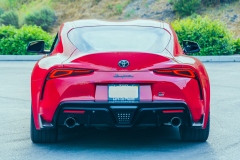
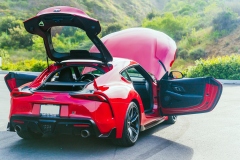
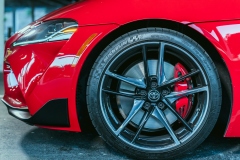


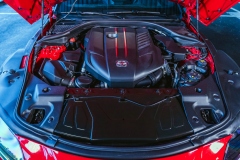
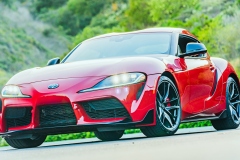
15 thoughts on “Road Test: 2020 Toyota Supra Premium”